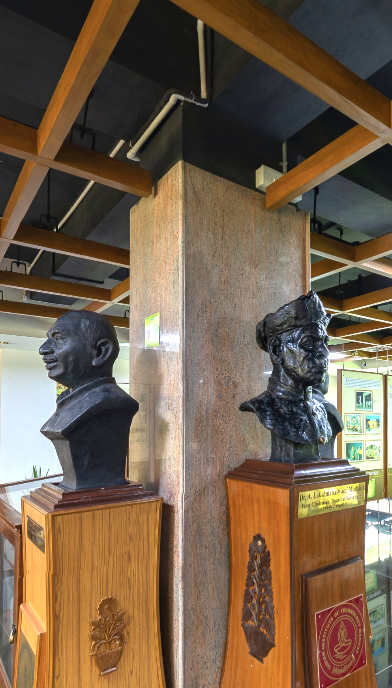Thermodynamics Laboratory, IIT Madras

- Photographs , Academic Facilities , 1960s
The Annual Report of IIT Madras, 1966 mentions that the Thermodynamics and Combustion Engineering Laboratory was completed in the year under report (1966-1967). According to the Mechanical Engineering Department website of IIT Madras, Thermodynamics and Combustion Engineering Laboratory is one of the five thermal engineering laboratories of the Department of Mechanical Engineering at IIT Madras (As of September 2021).
A view of the Central Library on Delhi Avenue

- Photographs , Campus Facilities, Campus Buildings, Academic Facilities , 1960s
This building is located on Delhi Avenue. It was opened on 21 July 1967 by Dr. A. L. Mudaliar (the first Chairman of the Board of Governors). This was the third place to serve as the IIT Madras Library, the first being on the third floor of A. C. College of Technology (until August 1961) and the second being on the second floor of the Building Sciences Block (until July 1967). The building in the photograph, which served as the Central Library for 33 years is now the IIT Madras Department of Management Studies (DoMS). The Annual Report of 1967-68 states that the total attendance of…
Senate Meeting at Humanities and Social Sciences Block, 1967

- Photographs , Administrators, Faculty , 1960s
The Senate met several times in a year. The Annual Report of IIT Madras, 1966 mentions that The Senate met seven times during the year, while the Annual Report of IIT Madras, 1967 notes that The Senate met six times during the year. Prof. B. Sengupto served as Director until 10 December 1967, so the photograph is likely to be from a Senate session prior to this date, since he is present at the meeting. From left, Prof. H. E. D. Zuern (Department of Metallurgy), Mr. V. Nazir Ahmed (Librarian), Prof. C. Ramasastry (Department of Physics), Prof. F. W. Lohr (Department of Mechanical…
Common emigrant [Catopsilia pomona]
![Common emigrant [Catopsilia pomona]](/sites/default/files/styles/medium/public/photographs/0004_51.jpg?itok=Terprh4k)
- Photographs , Flora & Fauna
The Common emigrant is also known as the Lemon emigrant, belonging to the family Pieridae. As the name suggests, the species derives its name from its habit of migration. The butterfly is found in Asia, Cambodia and parts of Australia. According to Dilmahconservation.org, “The Lemon Emigrant has a rapid, bouncy, irregular flight. It flies, even above tree tops, in great numbers during their migratory flight. They gather at mud patches and river beds regularly and even feed on fecal matter such as elephant dung during migration. Both forms can be seen together commonly, irrespective of a…
Great eggfly [Hypolimnas bolina]
![Great eggfly [Hypolimnas bolina]](/sites/default/files/styles/medium/public/photographs/0016_43.jpg?itok=AC4az7SX)
- Photographs , Flora & Fauna
The Great eggfly derives its unique name from the fact that it lays its eggs under leaves after inspecting the place for predators. They are even known to guard their brood, an uncommon act for butterflies and moths. According to the Natural History Museum website (nhm.ac.uk), “The great eggfly (Hypolimnas bolina) will also gladly sip sweat from human foreheads.” The website also makes note of the butterfly’s bold personality. Interestingly, “Male butterflies will also land on human heads and shoulders, using the vantage point as a lookout position to find potential mates.”
Plains cupid [Luthrodes pandava]
![Plains cupid [Luthrodes pandava]](/sites/default/files/styles/medium/public/photographs/0023_37.jpg?itok=4pGPVqu5)
- Photographs , Flora & Fauna
The butterfly is also known as the Cycad blue, owing to the fact that it feeds on a breed of plants of the cycad class. It is among the few butterflies to do so. According to website Learnaboutbutterflies.com, “The butterflies are usually seen in one's and two's, either sitting on low foliage, or nectaring at the flowers of various wild or cultivated herbaceous plants. Sometimes however they can be quite abundant, with up to a dozen fluttering about at a patch of flowers. At these times the males can be quite aggressive towards each other, and appear to own and defend territories.”
Pea blue [Lampides boeticus]
![Pea blue [Lampides boeticus]](/sites/default/files/styles/medium/public/photographs/0029_26.jpg?itok=R1vYcyIM)
- Photographs , Flora & Fauna
According to Wikipedia, “The Latin species name boeticus refers to Baetica, a province of the Roman Empire in the Iberian Peninsula. Its common name refers to the long streamers on its hind wings, the male's bright iridescent blue colour, and peas, which is the typical host plant of the butterfly.” The butterfly has a wingspan of 24-34 mm.
Forget-me-not [Catochrysops strabo]
![Forget-me-not [Catochrysops strabo]](/sites/default/files/styles/medium/public/photographs/0014_43.jpg?itok=6EbNitiY)
- Photographs , Flora & Fauna
The Forget-me-not belongs to the lycaenids or blues family.It has a wingspan of 25-30 mm. According to nature enthusiast Sarangapani Neog, “The adult is a sun-lover. Its flight is fast and erratic, a meter or two above the ground. The male is often seen circling the larval food plant in search of females.” (Indiabiodiversity.org).
Striped tiger / Common tiger [Danaus genutia] mating
![Striped tiger / Common tiger [Danaus genutia] mating](/sites/default/files/styles/medium/public/photographs/0024_35.jpg?itok=X4HMgk4b)
- Photographs , Flora & Fauna
The Common tiger is one of the most common butterflies of India. It is also known as the Striped tiger in order to differentiate it from the Plain tiger, which is also common and similar to the Common tiger in appearance. The wingspan of the Common tiger is 70-95 mm. According to Wikipedia, “Members of this genus are leathery, tough to kill and fake death. Since they are unpleasant to smell and taste, they are soon released by the predators, recover and fly off soon thereafter.” The butterfly is known to sequester toxins from plants such as those from the Milkweed family. This serves as a…
Indian cupid [Chilades parrhasius]
![Indian cupid [Chilades parrhasius]](/sites/default/files/styles/medium/public/photographs/0018_40.jpg?itok=4o8WYdp7)
- Photographs , Flora & Fauna
According to the website Learnaboutbutterflies.com, “The genus Chilades includes one of the smallest known butterfly species on Earth - the Madagascan Grass Blue Chilades (Freyeria) miniscula, which has a wingspan of only 9mm.” The website also makes note of the feeding behaviour of the Indian cupid, “They usually hold their wings erect when feeding or at rest, but will sometimes bask with them held half open in cloudy weather conditions.”
Lesser grass blue [Zizina Otis]
![Lesser grass blue [Zizina Otis]](/sites/default/files/styles/medium/public/photographs/0031_26.jpg?itok=eT_6RXcu)
- Photographs , Flora & Fauna
The Lesser grass blue has a wingspan of 22-27 mm. It flies close to the ground and is commonly seen in flowers. It is often misidentified as the Common grass blue (Zizina labradus).
Crimson rose [Pachliopta hector]
![Crimson rose [Pachliopta hector]](/sites/default/files/styles/medium/public/photographs/0008_49.jpg?itok=LKFXBYm1)
- Photographs , Flora & Fauna
The Crimson rose is a large swallowtail butterfly which is found in India, Sri Lanka and Maldives. The butterfly is fond of flowers especially Lantana. According to Wikipedia, “The red body, slow peculiar flight, bright colouration and pattern of the wings are meant to indicate to predators that this butterfly is inedible, being well protected by the poisons it has sequestered from its larval food plant.” On a side note, the scientific name, given by Linnaeus, honours the Greek hero Hector.
Lesser grass blue [Zizina Otis]
![Lesser grass blue [Zizina Otis]](/sites/default/files/styles/medium/public/photographs/0021_37.jpg?itok=PtgUck-Z)
- Photographs , Flora & Fauna
The Lesser grass blue has a wingspan of 22-27 mm. It flies close to the ground and is commonly seen in flowers. It is often misidentified as the Common grass blue (Zizina labradus).
Striped tiger / Common tiger [Danaus genutia]
![Striped tiger / Common tiger [Danaus genutia]](/sites/default/files/styles/medium/public/photographs/0025_34.jpg?itok=kMla_m29)
- Photographs , Flora & Fauna
The Common tiger is one of the most common butterflies of India. It is also known as the Striped tiger in order to differentiate it from the Plain tiger, which is also common and similar to the Common tiger in appearance. The wingspan of the Common tiger is 70-95 mm. According to Wikipedia, “Members of this genus are leathery, tough to kill and fake death. Since they are unpleasant to smell and taste, they are soon released by the predators, recover and fly off soon thereafter.” The butterfly is known to sequester toxins from plants such as those from the Milkweed family. This serves as a…
Indian cupid [Chilades parrhasius]
![Indian cupid [Chilades parrhasius]](/sites/default/files/styles/medium/public/photographs/0011_46.jpg?itok=_r4jI-IE)
- Photographs , Flora & Fauna
According to the website Learnaboutbutterflies.com, “The genus Chilades includes one of the smallest known butterfly species on Earth - the Madagascan Grass Blue Chilades (Freyeria) miniscula, which has a wingspan of only 9mm.” The website also makes note of the feeding behaviour of the Indian cupid, “They usually hold their wings erect when feeding or at rest, but will sometimes bask with them held half open in cloudy weather conditions.”
- Contribute
to the Centre -
Monetary
Support - Digital
Material









